Updated 11 Mar 2018: added 2nd grave photo + Brattle Farm Museum youTube video
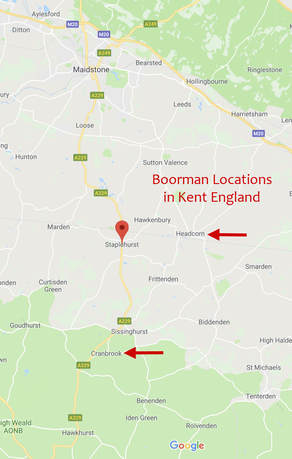
Terry’s five-times-great (5G) Grandfather William BOORMAN Jr was born about 1719, probably in Headcorn Kent England, the son of William BOORMAN Sr (1692-1771) and Sarah CHAPMAN (1688-1755). His parent’s marriage was recorded in the St Peter and St Paul Anglican church register in Headcorn Kent on 14 Oct 1718, and years later they were subsequently buried in Headcorn, conveniently listing their six children on their gravestone. William Jr was their oldest child.
The earliest record we have of William Jr is from 1725 when he was bequeathed £5 by his paternal grandmother Elizabeth BOORMAN (nee HAYWARD) who died in Cranbrook in 1731. Then on 23 Oct 1744, this William married Mercelina "Mercy" KNOWLDEN (1720-1750) in Linton (just south of Maidstone, and about 12km north of Staplehurst). The distances here aren’t large, but these towns and villages were still distinct, so I wonder how and why these two met? I have not yet researched the Knowlden family so can only guess that religion or business could have been their point of contact.
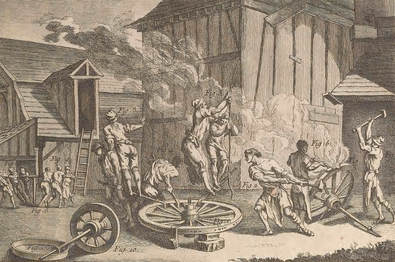 “This plate published in a volume of Encyclopédie in 1769 shows both
“This plate published in a volume of Encyclopédie in 1769 shows bothmethods of shoeing a wheel. In the centre the labourers are using hammers
and "devils" to fit a hoop onto the felloe, and on the right they're
hammering strakes into place.”
Attribute: By Denis Diderot - Encyclopédie, Public Domain, https://commons.wikimedia.org/w/index.php?curid=54996506
William Sr. was a wheelwright, a skilled trade that must have afforded him a good living as he was rated for property in Headcorn between 1723 and 1754 (at least). He died in 1771. His son William Jr also became a wheelwright, probably apprenticing with his father. At some point before 1750 he moved to Staplehurst (only about 6 km west of Headcorn) to apply his trade there. His parents remained in Headcorn.
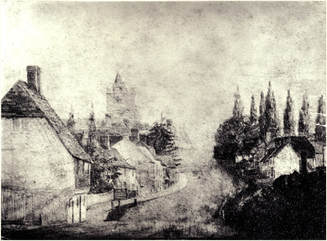 Painting of Staplehurst Kent ca 1824, Ref T81
Painting of Staplehurst Kent ca 1824, Ref T81http://www.staplehurstsociety.org/pageT81.html
Another researcher also suggests: “I think it was this William who was a tenant on some of the Bly Court lands in Staplehurst. He bought Lower Grove, the house used as a Meeting House, then leased it to Jacob CHAPMAN the Minister on 30 Jan 1766. His Workshop was part of the same site.” (I wonder if the minister was related to William's mother’s CHAPMAN family?). The “new” United Reform Church built in 1825 still stands on the corner site, and was previously known as the Congregational Church as back as far as 1662 before they merged with the Presbyterians. But by whatever name, they were all non-conformists. Regarding Bly Court, the Bly Cottages are located a short distance down Chapel Lane next to the Providence Strict Baptist Chapel (that wikipedia says was previously a barn), so it was very possible for William to have lived on these lands close to his wheelwright shop.
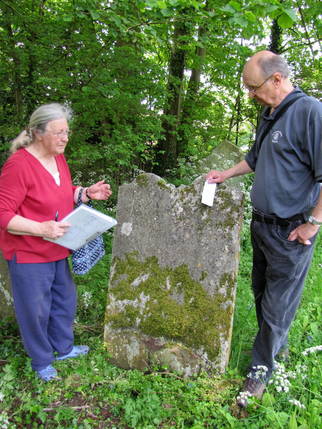 Anita and Terry discussing the grave of William Boorman,
Anita and Terry discussing the grave of William Boorman,who died in 1790, and his two wives, Mercy and Jane.
We had the pleasure of visiting Staplehurst in 2012 on an memorable trip to England, and saw first hand the grave of William Jr together with both his wives Mercy and Jane. The neighbouring stone was erected for William’s son William III and his wive Ann nee WELLER. Not that you could tell from looking at the stones as they were virtually unreadable. So we were unsure which stone was for which William. In fact we wouldn’t have been able to find these stones at all without the help of some friendly folks in the church who referred us to a woman from the local historical society. After we phoned her, Anita quickly arrived with her Monument Inscription booklet in hand, and led us to the BOORMAN graves. She had been one of the volunteers who transcribed the stones over 20 year earlier (perhaps as early as 1980) when they were somewhat more readable. Even so, she said they worked at night and shone flashlights obliquely so the shadows would improve the relief and visibility of the inscriptions. The Staplehurst Society's MI index has been posted on their website and, together with the will, have become the main sources for this family’s information. Previous monument transcriptions had been recorded back in 1922 by Leland Duncan, a member of the Kent Archeaological Society. Some of the details vary between these two transciption. For instance: Did Mercy, William’s first wife, die at age 30 or 36?
“He made his will on 19 Mar 1785 when wife Jane was still alive. Ref. No. Kent Archive Office PRC17/102.22. Jane was provided for: youngest [?] son Anthony got 300 pounds if he returned home: son William of Headcorn got his father’s house and land in Staplehurst: and daughter Mercy and son-in-law James Carpenter got land in Cranbrook. By 1818 son William was William Boorman, wheelwright of Staplehurst.”
We know the least about son Anthony BOORMAN. He was alive in 1785, but I can’t find record of his birth or marriage or death in England. So perhaps he emigrated to one of the colonies? At this point I don’t even know if he ever returned home to collect his inheritance. £300 was a lot of money back then, and constituted at least half the value of his father's estate according to the probate notes (see image below). Anthony's two siblings would have been greatly relieved if he was a no show, because the will required each of them to pay £150 to Anthony as repayment of their debts owed to their father. Otherwise, these debts would be forgiven. I can image that such large payments would have caused quite a cashflow problem, as the real estate was not theirs to liquidate during their lifetimes. I would really like to find Anthony and see how his fortunes faired. Could he have been the eldest son?
Son William BOORMAN III (1746-1824) inherited the most land from his father. In 1785 he was living in Headcorn with his wife Ann (nee WELLER) and their ten children. Were they living on property that previously belonged to his grandfather? We haven’t yet found the grandfather’s will from about 1771 to find out details of that estate. But it would be fitting if a grandson took over his wheelwright business in Headcorn (just a guess at this point). William III inherited his father’s dwelling house or apartment with orchard and garden shop and timber yard in Staplehurst AND the additional properties there that were bequeathed to Jane. In a similar manner, these properties were in trust for their children upon their death (William would died in 1824 and Ann in 1829). In addition, William split the household goods and books with his sister, and inherited the balance of the estate. At some point after his father's death, William set up residence in Staplehurst (some say 1818?). William and Ann were buried in the Staplehurst churchyard beside his father.
William III’s youngest son Edward became the next BOORMAN wheelwright of Staplehurst, keeping up the tradition of trade if not the first name. However, Edward did not own his property according to tithe records. But that's another story!
I have posted further information on Terry's BOORMAN heritage on our Boorman page.
REFERENCES and FURTHER READING
The Staplehurst Society - http://www.staplehurstsociety.org/
The History of Staplehurst - http://www.staplehurstsociety.org/Staplehurst%20History.pdf
Bly Court Manor - https://www.britishlistedbuildings.co.uk/101060739-bly-court-manor-staplehurst#.Wp8-55PwYy9
Boorman Family Research by John Squier - http://squierj.freeyellow.com/TreeSquier/Boorman/Tree5A-Boorman.htm#833_William_Boorman
Kent Probate Index: Canterbury Probate Records (1396-1858) Database - https://wills.canterbury-cathedral.org/
Kent Archaeological Society - http://www.kentarchaeology.org.uk/
Kent Monument Inscriptions - http://www.kentarchaeology.org.uk/Research/Libr/MIs/MIslist.htm
Wheelwrights Guild History - The Worshipful Company of Wheelwrights - http://www.wheelwrights.org/history.php
The Wheelwright’s Craft, Witheridge Historical Archive -
http://www.witheridge-historical-archive.com/wheelwright.htm
Painting of Wheelwright Shop - “Interior of the Coach-Wheelwright's Shop at 4 1/2 Marshall Street, Soho, London” by Clare Atwood (1866-1962), held at the Museum of London (© the artist’s estate) -
https://artuk.org/discover/artworks/interior-of-the-coach-wheelwrights-shop-at-4-12-marshall-street-soho-london-50516
Wheelwright - wikipedia - https://en.wikipedia.org/wiki/Wheelwright
Brattle Farm Museum in Staplehurst Kent - youTube video shows old farm equipment, vehicles, tools and wheels:
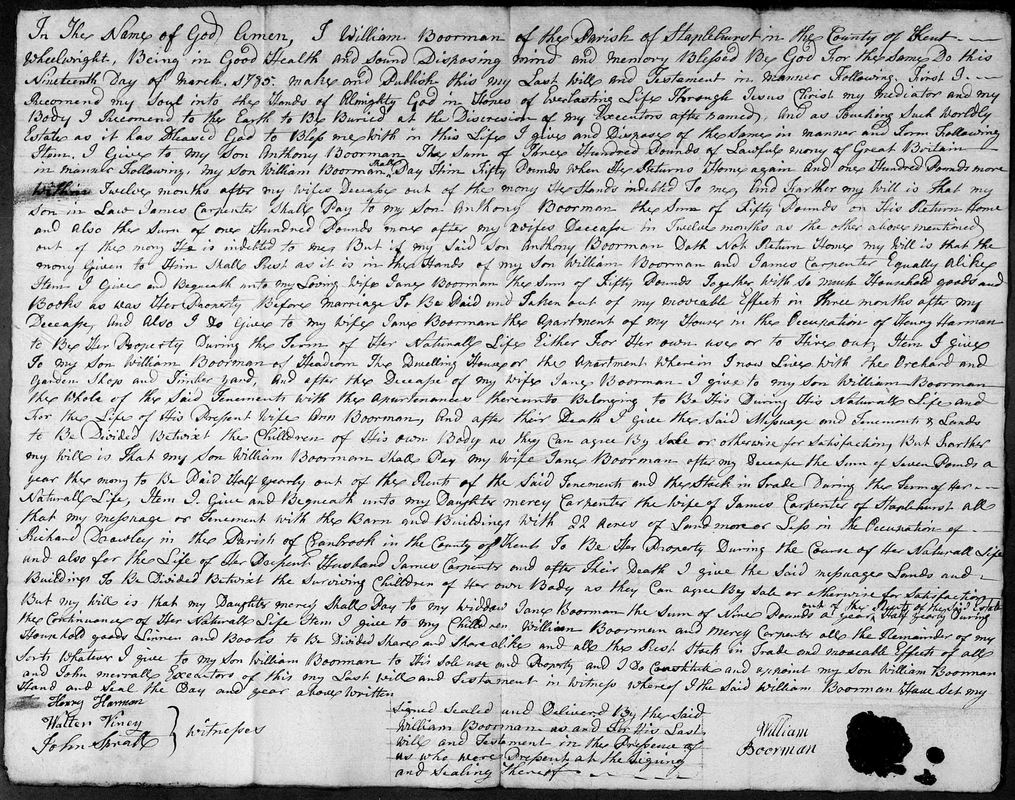
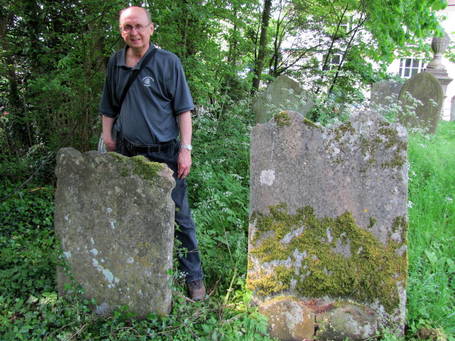
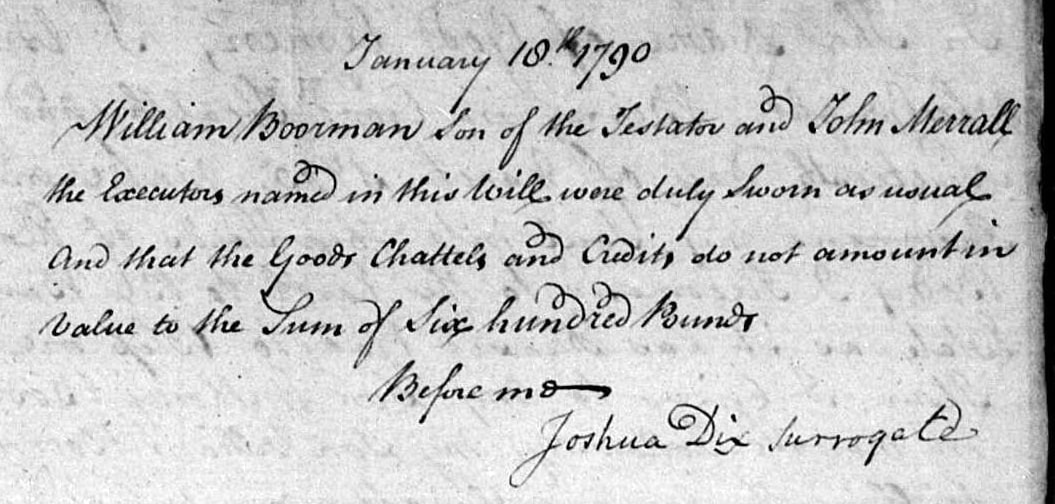
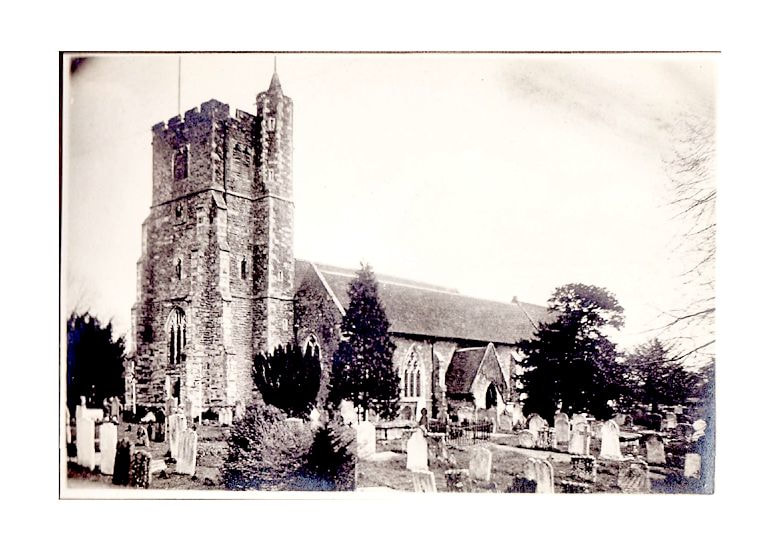
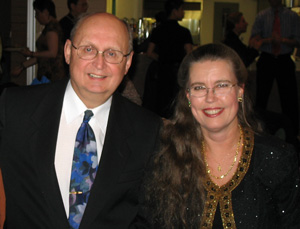
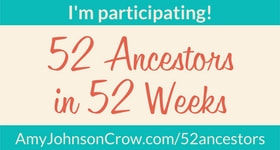
 RSS Feed
RSS Feed
